
Prisoners lie along the pathways lined
with crude dugout houses at Camp Ford. Housing was described
by one detainee as being small, dark, and dirty "log
shanties" that were "partly burrowed and partly
built." Hand-colored period drawing from Harper's Magazine,
courtesy of Alston Thoms.
Click images to enlarge
|

Civil War-era sketch of enslaved African
Americans building a stockade similar to the one at Camp Ford.
Drawing on file at Library of Congress.
|
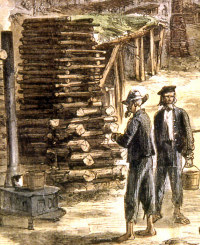
A variety of structures for shelter and
outdoor living were erected at the camp, leading one former
prisoner to write later, "What odd contrivances for shelter!
Here upright sticks sustain a simple thatch of leaves; there
poles fixed slantwise and overlain with bark, compose an Indian
lodge…Another's dwelling is of basket-work wrought out
of ashwood peelings." Drawing courtesy of Alston Thoms.
|
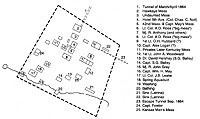
Escape attempts were periodically tried,
perhaps as a salve for boredom at the camp. This sketch by
a Union prisoner shows two of the approximate tunnel locations
along with other camp structures. Dotted lines indicate stockade
walls as defined by Texas A&M archeologists during investigations
in 1997. Drawing courtesy of Alston Thoms.
|
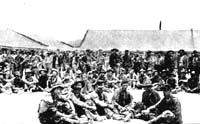
Camp Ford POWs from the 19th Iowa after their
release and return to New Orleans. Photo, courtesy of Alston
Thoms. |
|
Established in 1862 as a training camp for new Texas
Confederate recruits, Camp Ford was to have its mission dramatically
altered in barely a year's time. Union forces began to press the
Texas-Louisiana border and along the coastline near Galveston and,
in the ensuing actions, hundreds of Union soldiers were captured.
With no Confederate POW camp near at hand, Camp Ford was chosen
to receive the detainees. The first Federal POWs—fewer than
100 soldiers and sailors—arrived there in July 1863 to find
that few provisions had been made for their confinement. Many of
the prisoners constructed crude dugouts in the hill slopes to provide
themselves shelter; Confederate guards encircling the perimeters
of the small encampment served as the only deterrent to escape.
Arrival of more than 400 POWs in the following November
led to the construction of a log stockade that enclosed three acres
and a springfed creek. Within a 10-day period, a wood stockade was
raised using the labor of some 600 African-American slaves, pressed
into service from area plantations. Records suggest that captured
African American soldiers and sailors, who were not recognized as
POWs, were used as well as. POWs built their own living quarters—typically
log houses called "shebangs"—inside the stockade.
One prisoner housed in the original stockade described the bleak
encampment as: "…four acres-barren of timber and grass.
Sand blows desperately."
Following several defeats of Union forces in Louisiana
and Arkansas during the spring of 1864, more than 4,000 Union soldiers
were captured. Orders were issued to accommodate a new influx of
prisoners at Camp Ford. Over a two- or three-day period, several
hundred slaves labored to enlarge the stockade to encompass a 10-
to 16-acre area.
Although living conditions in the camp had been comparatively
good when the prisoners numbered only 100 to 250 per acre, they
deteriorated after April, 1864, when 400 or more men became crowded
into each acre of the newly enlarged camp. One prisoner wrote that,
soon after their arrival, the new POWs began to "arrange their
bivouacs into streets and began to amass green boughs for wigwams
or dig dark cavernous vaults for troglodytic dwellings." The
camp, he wrote, soon took on the aspect of a "wigwam metropolis."
Given the slope of the terrain, periodic rainstorms frequently turned
the encampment in a muddy and gully-ridden quagmire.
Original stockade at Camp Ford, as drawn by Col.
A.J.H. Duganne, a Federal POW at the camp. The prisoners eventually
built hundreds of structures at the camp—cabins, pithouses,
and dugouts. Note that, according to map key, housing was according
to mess assignment.
During the final years of its short-lived existence,
Camp Ford took on a more orderly appearance, what one prisoner described
as resembling "a very young prairie town." Streets were
laid out and lined with log structures, a parade ground was cleared,
and a market place under a pine-bough arbor was established.
Even so, boredom and a desire for freedom apparently
occupied the minds of many of the prisoners. Escape attempts, via
numerous furtively dug tunnels, met with varying success. In one
foiled attempt, a tunnel was dug at an excruciatingly slow pace
by a prisoner wielding only a small case knife; dirt was dumped
into a cigar box which was drawn out by a string. The tunnel had
reached 30 feet when the escape plot was discovered. In a more-successful
attempt, men from Massachusetts and Indiana managed to complete
a tunnel and head out in small squads bound for points north and
east. However, one of the last men in the tunnel got stuck and,
in a panic, alerted the guards. Due to the early warning, all but
two squads were recaptured.
With the end of the war in May 1865, Camp Ford was
abandoned. Historical records attest to considerable celebration
by POWs and guards alike, and to a large rummage sale in which the
newly-freed prisoners sold what few goods they had to local citizens
in need of utensils, dishes, and various items that had been made
by the prisoners.
In the ensuing years, several prisoners were to return
to Camp Ford to challenge old ghosts and recall lost friends. In
1894, S.A. Swanger visited the old stockade where he had been imprisoned.
Walking over the ground, he found prison relics, the remains of
red clay dugouts, cattle bones, and—in the cemetery area—a
few other bones, perhaps overlooked when the Federal government
disinterred the bodies of 286 Union prisoners after the war. Before
leaving, he took a last drink from the spring and a final look at
the hillside. He wrote later, "Farewell, old spot. And feeling
as if I never wanted to gaze upon it again, I left it…."
|
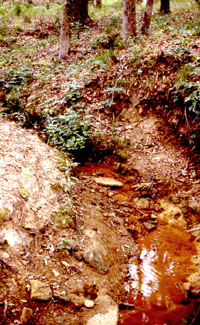
An artesian spring at Camp Ford furnished
water that, according to one of the prisoners, was cool, crystalline,
and impregnated with iron and sulphur, a combination thought
to make it a good tonic. Although the spring is no longer
there today, a small iron-colored stream runs in the same
creek bed. Evidence of small reservoirs dug by the POW's along
the creek was uncovered by Texas A&M archeologists. Photo
by Steve Black.
|
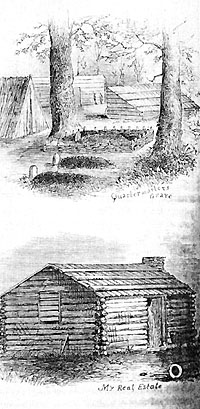
Examples of some of Camp Ford's better-built
POW housing, as recalled by former prisoner Col. A.J.H. Duganne.
Drawing courtesy of Alston Thoms.
|
|
Soon after their arrival, the POWs began to "arrange
their bivouacs into streets and began to amass green boughs
for wigwams or dark cavernous vaults for troglodytic dwellings,"
according to one prisoner already ensconced at the camp.
|
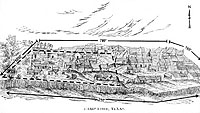 ( (
Camp Ford, shown in a period drawing of
its later years, when houses lined the streets and a market
area was constructed. A central thoroughfare in the camp was
tagged, "Fifth Avenue." Drawing, courtesy of Alston
Thoms.
|
|